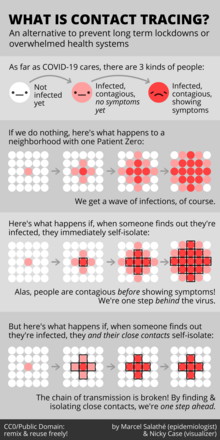
In public health, contact tracing is the process of identifying people who may have been exposed to an infected person ("contacts") and subsequent collection of further data to assess transmission.[1][2] By tracing the contacts of infected individuals, testing them for infection, and isolating or treating the infected, this public health tool aims to reduce infections in the population.[2] In addition to infection control, contact tracing serves as a means to identify high-risk and medically vulnerable populations who might be exposed to infection and facilitate appropriate medical care.[1] In doing so, public health officials utilize contact tracing to conduct disease surveillance and prevent outbreaks.[2] In cases of diseases of uncertain infectious potential, contact tracing is also sometimes performed to learn about disease characteristics, including infectiousness.[1][2] Contact tracing is not always the most efficient method of addressing infectious disease.[2] In areas of high disease prevalence, screening or focused testing may be more cost-effective.[1][2]
The goals of contact tracing include:[3]
- Interrupting ongoing transmission and reduce the spread of an infection
- Alerting contacts to the possibility of infection and offer preventive services or prophylactic care
- Alerting the general public about exposures or outbreaks (IE: COVID-19, Measles, TB, etc.)
- Offering diagnosis, counseling and treatment to already infected individuals
- If the infection is treatable, helping prevent reinfection of the originally infected patient
- Learning about the epidemiology of a disease in a particular population
- Being a tool in multifaceted prevention strategy to effectively curb the spread of an infectious disease.

- ^ a b c d "Coronavirus disease (COVID-19): Contact tracing". www.who.int. Retrieved 2022-11-03.
- ^ a b c d e f Brandt AM (August 2022). "The History of Contact Tracing and the Future of Public Health". American Journal of Public Health. 112 (8): 1097–1099. doi:10.2105/AJPH.2022.306949. PMC 9342804. PMID 35830671.
- ^ "Health Departments". Centers for Disease Control and Prevention. 2020-02-11. Retrieved 2022-11-03.